I saw this post on Craftzine yesterday about the new Japanese fashion of wearing colourful haramaki aka ‘belly warmers’. I think this is the best idea I’ve seen in a long time! Ever since the advent of low-rise jeans, women have been stuck with a little cold gap between the bottom of our shirts and the top of our jeans. This is a cool way to cover that gap, and why import one from Japan when we can all make our own?
I whipped this one up this morning as a prototype, so I left it plain, but just imagine how amazing it could look if you freezer paper stencilled a funky design on the fabric before sewing it…

When it was finished, I tried it on and was surprised by how warm I felt – it really does work, even when it’s just made from 2 layers of t-shirt fabric.
To make your own haramaki:
You can use any fabric with some stretch, so you can pull your haramaki on and off. I used a knit jersey (i.e. t-shirt fabric).
You will also need a sewing machine with a stretch stitch (pictured below).
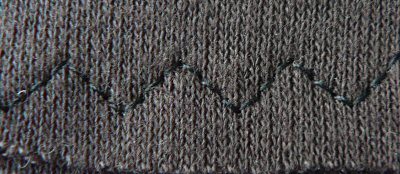
- Work out the dimensions you need. The height is up to you – I decided to go for an 8″ tall haramaki but you could make it longer if you want. The length of the haramaki depends on the size of your tummy..! Of course it would be easier to estimate for a skinny straight up-and-down Japanese model than for a regular curvy lady. I decided to make mine 30″ around (without giving too much away, that’s halfway between the measurements for my waist and my hips). If you want to wear it high up, make it a bit shorter than your halfway measurement, and if you want it to cover your hips, you may need to make it a little longer, depending on how stretchy your fabric is.
To get the fabric dimensions, the length is 1″ over the length you decided (mine is 30″ + 1″ = 31″) and the width is double the height plus 1″ (mine is 2×8″ + 1″ = 17″). Cut your fabric to these dimensions and lay out as shown (right side up):
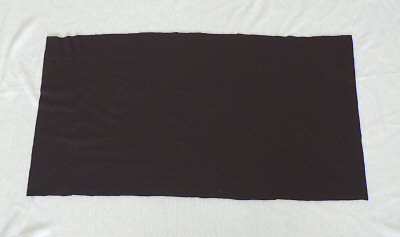
- Fold your fabric in half so the top meets the bottom, as shown below:
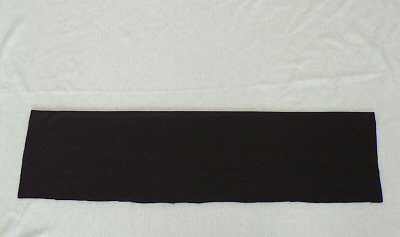
- Pin the 2 long sides together, all the way along. It’s better to space the pins more closely than you normally would, as the stretch fabric can get out of alignment more easily than a regular fabric:
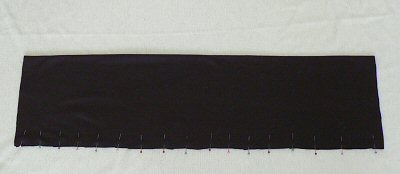
- Sew along the line you’ve pinned. You have 1/2″ seam allowance, but that 1/2″ includes the full width of the zig-zag stitch, so you may need to practice on scrap fabric first to see which guide line to follow on your sewing machine. Trim the extra seam allowance after sewing:
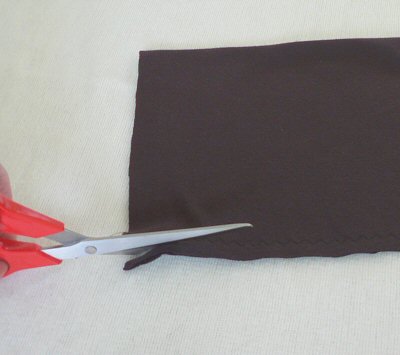
- You have just made a long tube. Stick your arm through the tube and grab onto the far edge of the tube:
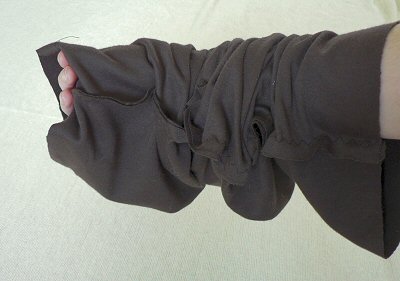
- Pull your arm back out of the tube, bringing that far edge of the tube back through the middle of the tube. Stop when the raw edges meet up, and align the edges:
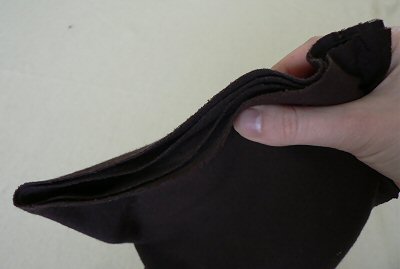
- Pin the inner and outer layers together, all around the raw edge:
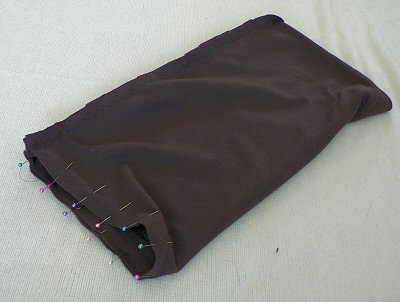
- To clarify, you should now have a tube that is half as long as before, made from 2 thicknesses of fabric. The pins should not close off the end of the tube:
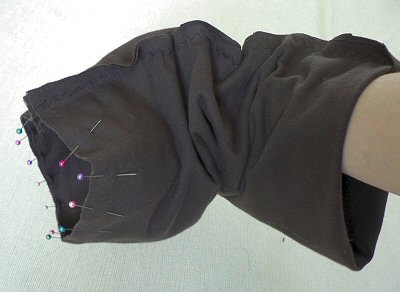
- Sew around the pinned edge (again, 1/2″ seam allowance), leaving a gap of about 3″. Turn the harimaki right side out through this gap:
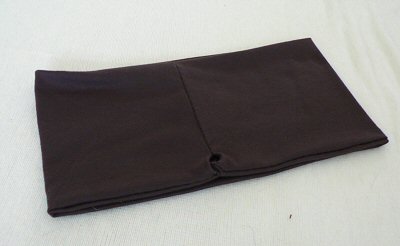
- Fold the edges of the gap under, and hand-sew the opening shut. That’s it! All finished!

I’ve been wearing mine all day and it’s warm and comfy and like having a hug all day long 🙂
Please leave me a comment if you like this idea or if you make one!
















yasufroggy said
It is wonderful to see the old Japanese thing back on stage with a new interest! Haramaki (?? meaning Tummy wrap) used to be regarded for the old man’s or kid’s wear. (Like keeping tummy warm when the children sleeps.) Of course they can be both practical and fashionable! My daughter just asked me for one, a knitted one, for she does ballet for a long time every day. I am interested in the idea to use the small T-shirt, too. Maybe I will make both. Thank you!
Emily said
Thank you for this tutorial. What should I do if I have a very curvy figure?
98 cm waist and 124 cm hip with a large chest?
I am worried that it will either be too small for me to put it on or too big for my waists.
How should I figure the fabric size?
Thank you so much!
June said
If you can find a long fitted T-shirt that fits you well in the waist-hip area and measure the width of that, that’ll be a good starting point. Look for a very stretchy jersey fabric that can accommodate your hips without gaping too much at the waist.
Or, alternatively, make a ‘cheater’ version – cut off a well-fitting t-shirt below the arms and discard the top part of the shirt (you can either hem the cut edge or leave it raw, as t-shirt fabric doesn’t fray). Wear it a little lower so you get good coverage over your hips, and you’re done! It’s only one layer thick, but I find it’s still enough to keep me warm 🙂
Baudien said
Dear June I want to try to make an haramaki. But I am dutch and we use other size designation then your description. Could you give me some more information which size
30” is? Is there an other way to describe this?
Thank you so much!
Regards,
Baudien
June said
Google is your friend, here! If you ever see a measurement unit you don’t understand, Google can convert it for you.
For example, type 30″ in cm into Google and it’ll give you the number you need in a unit you recognise. (You can do this with any pair of units that measure the same thing, e.g. two lengths, weights, currencies, temperatures, etc – it’s very useful!)
A.M. Hewes said
I had a hara maki which was stolen. It was a heavy knit, like a sweater, and twice as long as what is described here. By doubling it, it was similar to a fanny pack, capable of holding lunch, a phone, fire starter for outdoor lunches on chilly days, and more.
Fooldezi Julie said
Sok sz
Linda Kinnunen said
Thank you for the harimaki tutorial. I just read about the usefulness of a harimaki in Michael Tierra’s book, “Chinese Traditional Herbal Medicine”. He recommends wearing one to support Kidney health. I am a Zen Shiatsu practitioner in Minnesota and enjoy your site!
Alexia said
Like Chris says above, I saw this on TV. Am definitely going to make one for myself…..maybe more to hold in my stomach though. Has anyone done one for that specific issue?
Chris Simpson said
I just saw these on TV. They were called a Hip-T and were selling for – I can’t believe it – $35. I thought it looked like a great idea at the time but the price was not what I would pay. I will have to try this for my daughters using thrift store shirts. I should be able to make 1 or 2 for a dollar. Thanks.
Noura Barakat said
What lovely idea, I was making my own by knitting cotton thread, I will try -hopefully soon- this briliant idea.
Thank you
Hanni said
Thanks for this nice tutorial. I made two waist warmers. 🙂
sherry said
I never heard of a belly warmer before. It’s hard for me to find shirts long enough. I am going to make several of these in different colors to use as a layered look. Thanks! Great idea.
Bella said
Thanks heaps for this. I have to go out dog walking and i wouldnt go without something to comfort me. Made a belly warmer out of two old tshirts and it took no time at all. Hurrah!!
Jennifer said
Thank you! I am always befuddled by the “turn the tube halfway” concept, but it never fails when I follow the directions. My mom suggested the elastic stitch–looks like a fancy fence embroidery– as a stretchier alternative. I tried and almost 8″ difference between the top and bottom measurements: that worked 2 out of 3, but the tops slump down, so their either aren’t tight enough or I was making them too tall.
June said
I made a “haramaki version 2.0” where I tapered the top half at each side before stitching up the tube, to make the waist narrower. I think it’s a better solution for curvier ladies (with a large difference between waist and hip measurements) because I found the same thing – if you make it narrower to fit your waist better, it rides up because it’s too narrow for your hips…
I must find time to write up the modified tutorial when I’m settled here in South Africa and my luggage (including the sewing machine and photo equipment!) has arrived 🙂
mina said
thank you, i have copied your instruction, this will be my project.
William said
Wished I’d read this before I started, I worked on one yesterday and thought it was going great, (I have a simple sewing machine but haven’t sewn a project in 20 years) I ended up with a pillow…
Tomorrow I’ll start seem ripping and follow directions. :o(
M said
Amei a ideia!!! H
susan said
Yes I am wearing a Haramaki as I type this. I have made my own from just wrapping a length of stretch material around my abdomon,tucking the ends, then wear a mini skirt over that, very snug. I feel secure and will probably start making one on the sewing machine now that I have seen your excellent intructions, thank you, much appreciated, regards Susan
Kristi said
I actually use this for my 12 year old daughter!! Alot of the shirts she has are too short for school (usually hit right at her hips) Since she is self conscious about bending over at her locker, I decided to whip up a couple of these in various colors for her to wear under her shirts for the layered look. They have worked FABULOUSLY even in the hot weather! She LOVES them and has asked me to make her several more! Thanks for the tutorial and the idea! Saved me from having to spend alot of money (even at the thrift store) to find school appropriate shirts! 🙂